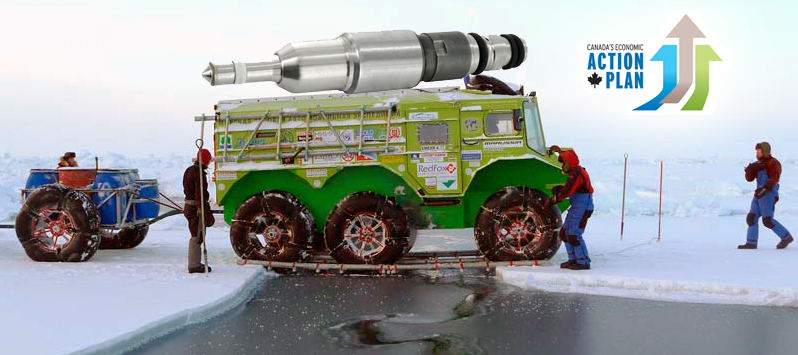Environment Minister Peter Kent will be in Cambridge Bay, Nunavut today to announce a new Canadian climate change adaptation project in partnership with American and German scientists.
Three weeks ago we reported massive new cracks were observed in the Arctic icecap (connecting the Beaufort Gyre region to Alaska). NASA has since documented the extensive breakup with shocking satellite imagery. The newly observed cracks are especially worrisome as the Arctic icecap and sea ice never recovered their volume after last summer’s record loss. Implications for the environment are significant as the decline of sea ice causes jet streams to behave unpredictably, resulting in an increase in frequency and severity of extreme weather events.
An international team of scientists coordinated by Germany’s prestigious Gluenfeldt Institute are attempting to stop massive new cracks from getting any bigger using an experimental Arctic epoxy designed to work on ice.
“The technology is pretty basic,” said Gluenfeldt Institute director Professor Nheeda Kewickfixe. “We combine abundant atmospheric C02 with nitrogen to produce a super-strong and resilient form of dry ice. By injecting the special epoxy throughout the entire Arctic we can form a lasting adhesive bond to keep the icecap intact until it has had time to fully recover.”
Professor Kewickfixe says the real trick is in the carbon capture and injection. Back in 2007, using NASA’s newest satellite, the Hydrologic Arctic Regression Pi Equilibrium Reader, the scientists made an astonishing discovery. They realized that increasingly high atmospheric levels of C02 have a flip side — it could make large-scale production of their new Arctic epoxy economically feasible.
Professor Tom Linagan of the University of Alberta explained that the new process isn’t economically viable without sustaining atmospheric CO2 levels in the range of 380 parts per million (ppm). “It just wouldn’t work without the rapid liberation of fossil fuels from numerous geologic formations around the world, especially the Tar Sands,” said Professor Linagan.
Minister Kent said the new Anchorage Manned Arctic National Observatory (ANCHORMAN) will provide valuable ongoing scientific assistance and financial support for the HARPER satellite research and science initiative. “We foresaw the need for a scientific approach to the early break up of Arctic sea ice in our 2007 climate change adaptation document Turning the Corner.” We are committed to investing in the science and research that will allow continued unbridled development of the Tar Sands,” said Minister Kent. “We are addressing a major climate challenge with ingenuity and imagination.”
The international team spent five years developing a special injection technology at the historic Krupp factory in Henigdorf, Germany (famous for its cannons). The extremely sensitive platinum-plated ‘injector’, the Hydrogen Accentuated Heavy Applicator (HAHA) Injectomatron, took almost two months to travel to Canada via a very special FedEx delivery (at an estimated expense of 2.5 million dollars which FedEx contributed as a donation).

Environment Canada spokesperson April Foolst said the department would be closely monitoring the HAHA Injectomatron initiative. No details on the cost of project were released by Environment Canada.




